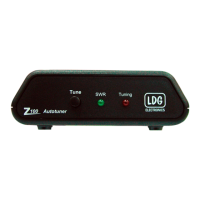Features
• Automatically matches antennas from 6 – 800 ohms impedance, or a 10:1 SWR
• Can be powered by a pair of 9 volt transistor radio batteries in series, providing hundreds
of tuning cycles
• Very low current consumption: 300 mA during turning, nearly zero current (effectively
off) when not tuning. Your Z-100 is ideal for battery-powered operations.
• Uses latching relays, retains tuned setting indefinitely even when power is completely
removed
• Tunes from memory in less than one half second. A full tune will take from 1 to 6
seconds.
Specifications
• Microprocessor controlled, switched L tuning network
• 200 tune memories for almost instant return to previously tuned frequencies
• Antenna impedance: 6 to 800 Ohms (approximately 10:1 SWR, 3:1 on 6 meters)
• Continuous coverage 1.8 to 54 MHz
• Power range: 0.1 - 125 watts, 50 watts on 6 meters.
• Latching Relays hold tuned setting indefinitely, even when power is removed
• Tunes nearly any coax fed antenna. Use optional Balun for long wires.
• Triple function tune control button
• Tuning time: 1 to 6 seconds, 3 average (0.1 second minimum in memory mode)
• DC power requirements: 7 to 18 volts DC @ 300 mA during tune
• Enclosure sizes: 5” x 5” x 1.5”
• Weight: 14 ounces
Getting to know your Z-100
Your Z-100 is a quality, precision instrument that will give you many years of outstanding
service; take a few minutes to get to know it.
Your Z-100 can be used with any transceiver or transmitter with coax output operating in the HF
range at no more than 125 watts output.
There is only one front panel control: the Tune button. This button begins a tuning cycle, and also
places the tuner in “bypass” mode; see operating instructions. Two front panel LEDs indicate
tuner activity and SWR.
There is no “Off” button. After tuning, your Z-100 automatically enters a “deep sleep” state in
which it draws nearly zero current, effectively off. Your Z-100 will automatically wake up the
next time you start a tuning cycle. Your Z-100 employs latching relays, which hold the tuned
setting indefinitely, even when DC power is completely removed.
4

